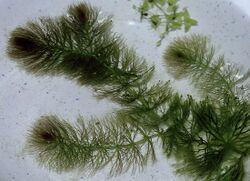Biology:Ceratophyllaceae
| Ceratophyllaceae | |
|---|---|

| |
| Ceratophyllum submersum | |
| Scientific classification | |
| Kingdom: | Plantae |
| Clade: | Tracheophytes |
| Clade: | Angiosperms |
| Order: | Ceratophyllales Link[1] |
| Family: | Ceratophyllaceae Gray |
| Genera | |
| |
Ceratophyllaceae is a cosmopolitan family of flowering plants including one living genus[3] commonly found in ponds, marshes, and quiet streams in tropical and in temperate regions. It is the only extant family in the order Ceratophyllales.[4] Species are commonly called coontails or hornworts, although hornwort is also used for unrelated plants of the division Anthocerotophyta.
Living Ceratophyllum grows completely submerged, usually, though not always, floating on the surface, and does not tolerate drought.
Taxonomy
Ceratophyllaceae was considered a relative of Nymphaeaceae and included in Nymphaeales in the Cronquist system, but research has shown that it is not closely related to Nymphaeaceae or any other extant plant family. Some early molecular phylogenies suggested it was the sister group to all other angiosperms, but more recent research suggests that it is the sister group to the eudicots. The APG III system placed the family in its own order, the Ceratophyllales.[1][2][5] The APG IV system accepts the phylogeny shown below:[4]
| angiosperms |
| |||||||||||||||||||||||||||||||||||||||
The extinct family Montsechiaceae containing the genus Montsechia has also been placed in the order Ceratophyllales.[6]
Genera
The family contains one living genus, and several extinct genera described from the fossil record, including one of the earliest fruit bearing (in the form of an achene) plants, the Dakota formation freshwater genus Donlesia from Early Cretaceous.[7]
- Ceratophyllum
- †Ceratostratiotes
- †Donlesia
References
- ↑ 1.0 1.1 Angiosperm Phylogeny Group (2009). "An update of the Angiosperm Phylogeny Group classification for the orders and families of flowering plants: APG III". Botanical Journal of the Linnean Society 161 (2): 105–121. doi:10.1111/j.1095-8339.2009.00996.x.
- ↑ 2.0 2.1 Kew World Checklist of Selected Plant Families
- ↑ Christenhusz, M. J. M.; Byng, J. W. (2016). "The number of known plants species in the world and its annual increase". Phytotaxa 261 (3): 201–217. doi:10.11646/phytotaxa.261.3.1. http://biotaxa.org/Phytotaxa/article/download/phytotaxa.261.3.1/20598.
- ↑ 4.0 4.1 Angiosperm Phylogeny Group (2016). "An update of the Angiosperm Phylogeny Group classification for the orders and families of flowering plants: APG IV". Botanical Journal of the Linnean Society 181 (1): 1–20. doi:10.1111/boj.12385.
- ↑ Angiosperm Phylogeny Web: Ceratophyllales
- ↑ Gomez, Bernard; Daviero-Gomez, Véronique; Coiffard, Clément; Barral, Abel; Martín-Closas, Carles; Dilcher, David L. (2020). "Montsechia vidalii from the Barremian of Spain, the earliest known submerged aquatic angiosperm, and its systematic relationship to Ceratophyllum". Taxon 69 (6): 1273–1292. doi:10.1002/tax.12409.
- ↑ Dilcher, David L.; Wang, Hongshan (December 2009). "An Early Cretaceous fruit with affinities to Ceratophyllaceae". American Journal of Botany 96 (12): 2256–2269. doi:10.3732/ajb.0900049. PMID 21622341.
Wikidata ☰ Q12012524 entry
 |

